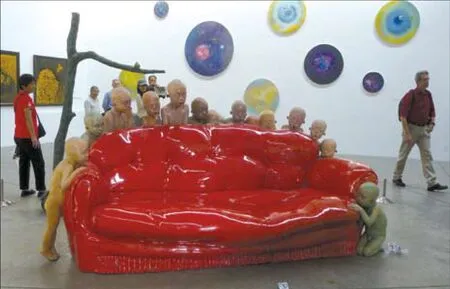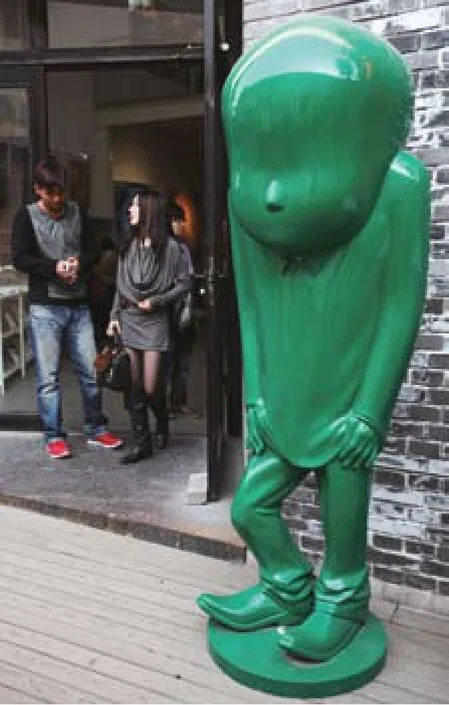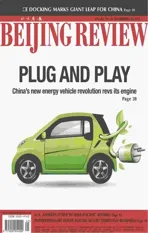798 Transforms Modern Art Scene
2011-10-14ByYULINTAO
By YU LINTAO
798 Transforms Modern Art Scene
By YU LINTAO
Booming zone in Beijing is morphing from an Eden of creation into a high-end art market
In 10 years, an abandoned factory complex has developed into one of Beijing’s cultural landmarks, the 798 Art Zone.Gone are the days when the area, without streetlights or public services such as taxis and toilets, provided a haven for many poor artists to paint their dreams. Some had their dreams come true while others did not, but one thing is now certain: the area has made a name for itself as China’s contemporary art frontier, thanks to the perseverance of its original habitants in art creation.
As a growing number of art studios and galleries opened there, the zone operator drew a different blueprint for it: a stateof-the-art exhibition and trade center for paintings, sculptures and other artistic and creative works.
The Fifth 798 Art Festival, which was held from September 24 to October 16, offered some clues to this new orientation. The festival has exhibited a number of paintings,sculptures, installations and photographs of world-renowned contemporary artists from China, the United States, Japan and South Korea.
During the 22-day event, 20 galleries located in the zone held theme exhibitions,and 84 art institutions staged 108 exhibitions.
The event, participated by artists from 25 countries, has attracted 750,000 visitors of whom 40 percent are foreigners, said statistics from the organizing committee.
Such a change, from an artists’ haven to a prosperous art business center, was inevitable for 798 and its overseas counterparts such as New York’s SoHo District, said Robert Bernell, an American art publisher who opened Time Zone 8 Book Club in the area in 2002.
“One thing is certain: The change has begun and big art agencies and famous brands will eventually replace individual artists here,” said Bernell.
Rise to fame
The art zone is attractive for foreigners because it’s a symbol of modern China and its active creation of contemporary art, while the Great Wall and Forbidden City represent China’s past, said Bernell.
The art zone was born in 2000, when the landlord Seven Star Huadian Science and Technology Group relocated its moneylosing subsidiary in the area elsewhere.With red-brick walls, gigantic Bauhaus-style workshops and Mao-era slogans, the deserted 798 factory complex in Chaoyang District attracted artists seeking an art Eden.

CREATIVE: Art lovers visit an exhibition on September 24 during the Fifth 798 Art Festival in Beijing
“I was impressed by dynamic art creation here when I first came to 798. Its spacious workshops and cheap rents are also very attractive,” said Bernell.
By word-of-mouth, more artists and many of Bernell’s friends opened or relocated their studios to the 798.
In 2003, the 798 Art Zone was named byTimemagazine as one of the 22 cultural landmarks in the world. After successfully boycotting an attempt to rebuild the old factory into a hi-tech electronics zone in 2005,the artists witnessed the establishment of a“creative district and cultural park” in 798 in 2006.
A different roadmap has unfolded since then.
New orientation
contemporary sculptures stand beside big rusty machinery; fashion shows and art exhibitions are given in spacious workshops. Later operation has turned a former quiet place for art creation into a hightraf fi c art hub for not only artists but also art merchants, visitors and tourists.
“The art creation boom in the 798 area before 2006 was just a kind of spontaneous cultural phenomenon,” said Liu Gang, Vice General Manager of Beijing 798 Creative Industry Investment Co. Ltd. Beijing Seven Star established its investment arm in 2007 to build the zone into an exhibition and trade platform for art works.
In 2006, the zone operator set up a management office and lifted the threshold for tenants. Since then a number of heavyweight art institutions such as Pace Beijing,the Iberia Center for Contemporary Art,Galleria Continua and the Ullens Center for Contemporary Art have moved into the zone.
“The 798 Art Zone is now primarily a place where artists hold exhibitions, giving more than 2,000 exhibitions, performances and other art and cultural activities every year,” said Zhang Guohua, head of the 798 Art Zone Development and Administration Of fi ce.
The new orientation has also caused much controversy. With increases in rents and tourist numbers, some artists have moved out of the art zone because they thought it was no longer suitable for their creation.

ORIGINALITY: A sculptured creation is displayed at the 798 Art Zone during its fifth festival on October 6
“Artists who closed their studios here still give exhibitions, hang out and talk over a couple of coffee with friends in 798, “ said Bernell. “They always draw inspiration for creation from the gatherings they have here.”
He compared 798 with other art districts developed from deserted factories worldwide. “While many art zones eventually developed into commercial areas, the 798 found itself a different way,” he said.
Even those who moved out can still settle down in artistic areas nearby, such as Caochangdi and Huantie neighborhoods which, together with the 798, will form an art cluster, Liu said.
“In fact, the transformation of 798 is bene fi ting these art districts too, by providing artists opportunities to enter world eminent galleries, of which there are many in the 798 now,” he said.
As a frontier of contemporary art in China, 798 is of experimental significance.That is why “the zone operator should pay more attention to the protection and fostering of domestic art institutions and Chinese contemporary art, and at the same time be more open and inclusive to artists,” said Li Xiangqun, professor of Tsinghua Academy of Arts and Design, who has a studio in the zone.
By the end of 2010, about 455 studios,galleries, shops and restaurants had been established in the area, increasing from several dozens in early 2002. “The art zone also attracted more than 50 overseas art agencies,”said Liu.
